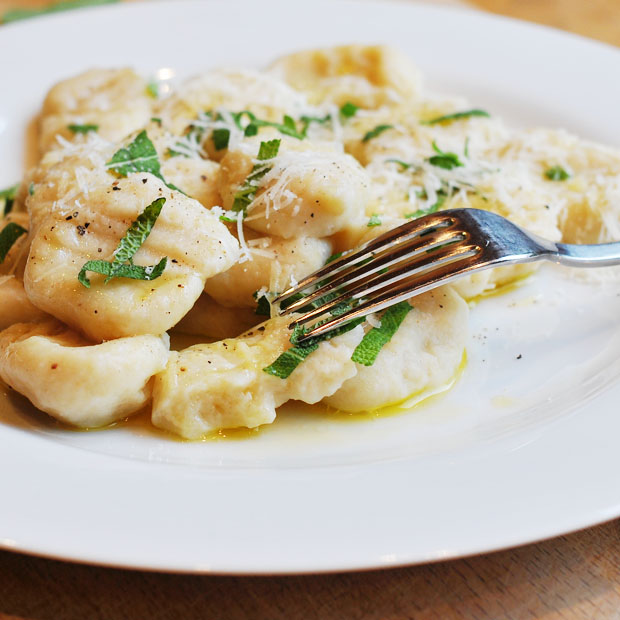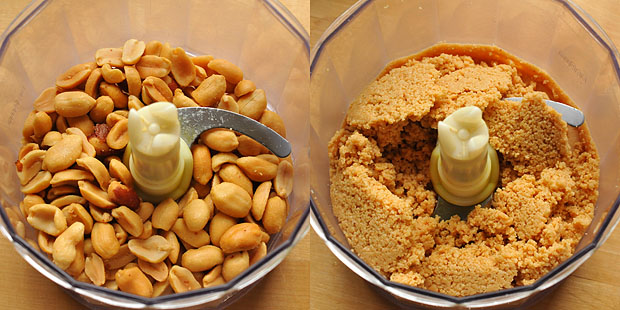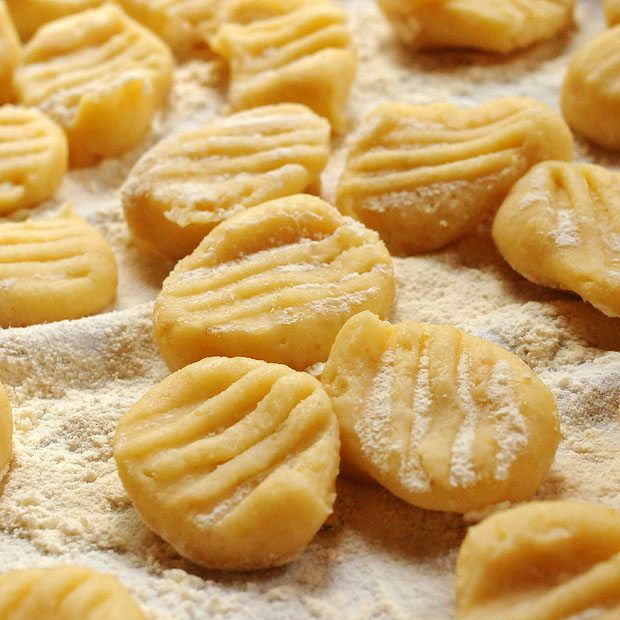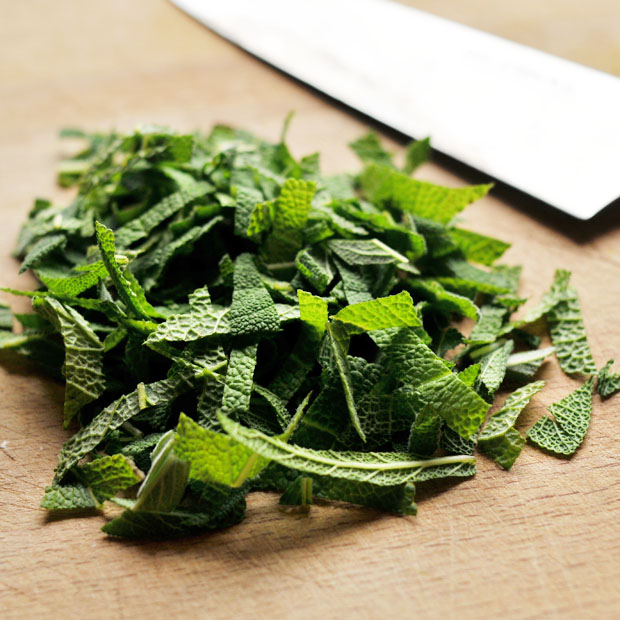
In my everday cooking sage is really underutilized. The only dish I can think of with sage that I’ve prepared during the last couple of years is potato gnocchi. So this was indeed the most likely candidate for experimentation in this month’s TGRWT #21. Potato gnocchi are one of those dishes that I suddenly feel a craving for, and I make it every now and then. When I get things right the gnocchi have a very light texture which fits nice with the melted butter and cheese. This time I decided to incorporate the peanuts into the gnocchi and apart from that stick to the original recipe.
While cooking I tried to chew some peanuts with a sage leaf, and this was a quite remarkable experience. The roasted peanut flavors blended into the sage, and the sensation was stronger than what is usually the case from the previous TGRWT rounds. When tasting sage by itself it will actually remind me of peanuts and vice versa. The last time I had a similar strong sensation was when combining roasted cauliflower with a cocoa agar gel.

I used a mini-food processor to grind the peanutes to a coarse powder.
Gnocchi with peanuts and sage
1 kg mealy/floury potatoes
100 g roasted peanuts
50 g butter
1 egg
250-300 g flour
1 t salt
For serving:
melted butter
chopped sage
grated parmesan
black pepper
Grind peanuts to coarse powder. Boil (or bake) potatoes (preferably unpeeled) until soft. Drain. While the potatoes are still hot, peel them and mash them. Add peanuts, butter, salt, egg and about half of the flour. Mix. Slowly add more flour until you get a soft and slightly sticky dough. Use as little flour as possible, but remember that with less flour the gnocchi are more prone to fall apoart (the added egg helps bind the gnocchi together by the way). Make a roll, approximately 2.5 cm in diameter and cut 1.5 cm pieces. Press against the back of a fork for the characteristic pattern, and place the gnocchi on a towel sprinkled with flour or semolina. Bring a large pot of salted water to a slow boil (is the salt really necessary here?) and cook the gnocchi for 2-3 minutes, or until they float to the surface. Remove from the water and drain. Serve with melted butter, chopped sage and plenty of grated parmesan and ground black pepper.

Gnocchi ready to be cooked. Use too much flour in the dough and you get boiled lumps of flour. Use too little flour and your gnocchi will fall apart.
Verdict: The amount of peanuts used gave a noticeable, yet mild nutty flavor which actually fitted the gnocchi quite nice (for future gnocchi attempts I can imagine even trying other nuts as well, such as hazelnuts or walnuts). The sage works very well as an aromatic and fresh component together with the more “heavy” flavors of potato, butter and parmesan. And frankly, I must say that the gnocchi were a success! I’ll make a note in the cook book that adding 100 g of peanuts works nice so I won’t forget the next time I make potato gnocchi.

A quick search over at The good scents company reveals that the butyraldehyde occurs naturally in both sage and roasted peanuts. But as I’ve pointed out several times previously – as long as we don’t know the impact odorants it’s impossible to tell whether this is the compound that ties sage and roasted peanuts together or not. If you’ve done litterature searches for impact odorants of roasted peanuts and sage, please tell me about it in the comments 🙂

Goodness, that is a triumph, it looks and sounds so delicious!
One trick I’ve learned through making hundreds of batches of gnocchi is that by adding not just one egg to the amount of potato you’re using, but rather 3-4 egg yolks, and adding them while your potatoes are hot, they cook slightly, helping to firm your dough, reduce the need for flour, and make your gnocchi lighter. But I want to try your flavor combo with them now!
Although it’s not hard to infer, it looks like you forgot to mention, in your recipe, to add the peanuts to the gnocchi dough 🙂
AJH: Will try that! But do you recommend to only use egg yolks, not the whites?
Enrico: You’re right! I’ve fixed it now 🙂
This looks like a nice recipe, and I’m exited to learn the sage and peanuts blend so well. It can be a nuisance though.
Since the old TGRWT with banana and cloves, almost every time I eat a banana it has a taste of cloves also. I really dislike cloves, but aparently my mind has been wired this way now.
I think I will go buy some sage to play in this round.
Lars: An interesting comment there about “rewiring” of the brain. I wonder if this could be studied with fMRI (= funtional magnetic resonance imaging)?
By recording images of the brain when eating
1) bananas alone,
2) cloves alone,
3) bananas and cloves together,
4) bananas alone,
and then comparing the images of 1) and 4) to se whether 4) has become more similar (or connected) to 2) after having eaten bananas and cloves together. (the experiment could of course be repeated for other food pairs)
If any of you have in depth knowledge of fMRI used in sensory science – do you think this could be a viable way of studying how certain pairings can change the perception of food, even when eaten alone?
Right, I just use the yolks. The water in the whites would need more flour to balance out the extra moisture, and both the whites and flour would just dilute the flavor.
What an excellent use of the two components together. Now I want to try your gnocchi. Great photos as well.
I often make a sage-brown butter sauce for my gnocchi or ravioli. I tried the peanuts in the gnocchi last night. I toasted raw Spanish peanuts to a smoky brown (strong) and then sauteed the sage in browned butter. The dark peanut was not overwhelming, and we agreed they were my best gnocchi yet. I wonder if browning the butter and sauteeing the sage altered the volatiles?